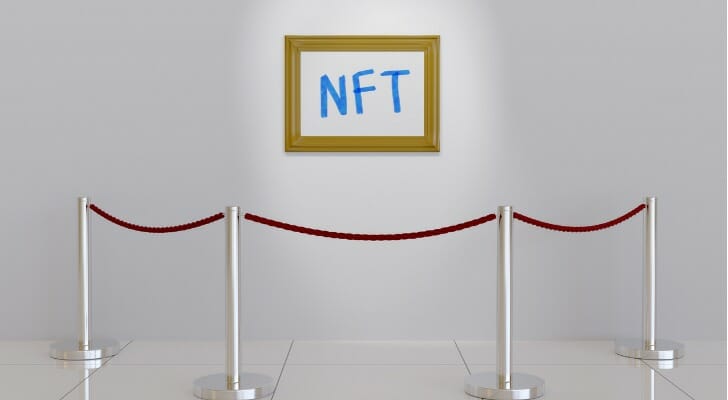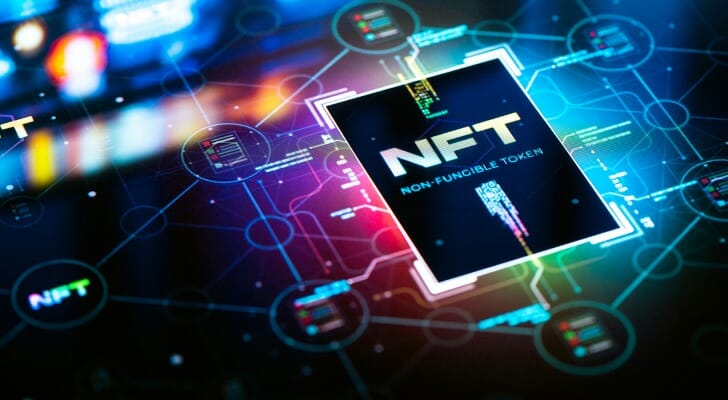 Non-fungible tokens, or NFTs, have become the next big thing for many traders who operate in a blockchain environment. Built on the same coding format as cryptocurrency, this market has scaled almost instantly. Traders have made fortunes overnight selling pictures of cartoon apes and copies of media that already exist. Buyers range from individual investors to multinational corporations. A few – most likely very few – have gotten rich very quickly. Here’s how it works.
Non-fungible tokens, or NFTs, have become the next big thing for many traders who operate in a blockchain environment. Built on the same coding format as cryptocurrency, this market has scaled almost instantly. Traders have made fortunes overnight selling pictures of cartoon apes and copies of media that already exist. Buyers range from individual investors to multinational corporations. A few – most likely very few – have gotten rich very quickly. Here’s how it works.
For help with investing in digital assets, including NFTs, consider working with a financial advisor.
What Are NFTs?
An NFT is a digital certificate that records who owns an asset. Most NFTs are created for digital assets, since this is a form of digital certification, but you can create an NFT certificate for anything. It is a chain of title.
Really. That’s it.
NFTs are based on the blockchain data storage format and are technologically the same as a token of cryptocurrency. In both cases, you take a file online and record an entry in the database showing who owns it. Then the database keeps track of that ownership as it changes hands.
Any asset can be a non-fungible asset. Currently the most popular format for NFTs has been images. However, people have made NFTs out of news articles, music, tweets, video game content and even physical objects. Think of it like art. Only one copy of the original Mona Lisa exists. It is owned by the nation of France. Anyone can take a photo or make prints of the Mona Lisa. In fact, anyone could even sit down and use oils to (try to) make an exact copy of the painting down to the last brushstroke. But no matter how perfect a copy, the French government owns the original and the Louvre will confirm that.
Should You Invest In NFTs?
 Probably not. At least not right away … or until and unless you have a great deal of insight into NFTs. Remember: they don’t have any intrinsic value so investors can’t make any judgment about how much they should be worth. With a stock, for example, you can judge the strength of a company’s business model and the health of its market. With a bond, you can evaluate the likelihood of repayment. In their current incarnation, however, NFTs exist almost entirely as a collectibles market. There is no way of judging the value of these assets other than a best guess as to how much someone in the future will want to own a cartoon ape or a journalist’s tweet.
Probably not. At least not right away … or until and unless you have a great deal of insight into NFTs. Remember: they don’t have any intrinsic value so investors can’t make any judgment about how much they should be worth. With a stock, for example, you can judge the strength of a company’s business model and the health of its market. With a bond, you can evaluate the likelihood of repayment. In their current incarnation, however, NFTs exist almost entirely as a collectibles market. There is no way of judging the value of these assets other than a best guess as to how much someone in the future will want to own a cartoon ape or a journalist’s tweet.
This problem is compounded by the fact that anyone who can see an NFT can own a perfect copy of the underlying asset. The only tradeable value is the certificate establishing you as the owner of some digital file that already exists on a million hard drives. At the same time, NFTs have no utility until and unless you trade them.
The lack of these stabilizing factors makes NFTs quite volatile, which is a hallmark of most, if not all, assets that have high speculative value and few fundamentals. Investors make their trades based on a best-guess of what other investors will want. This emphasizes emotional trading, which in turn leads to wild market swings. This is not unique to NFTs. It also characterizes markets such as precious metals and art.
Gold, for example, is a quintessential trading asset. As a commodity it has little utility beyond some minor properties as a semiconductor, and as a currency it is inherently deflationary. Historically it has been used as a monetary asset chiefly because of its unique combination of relative rarity and metallurgic resistance to corrosion, but today it has little utility beyond aesthetic appeal. So holding gold has no value. It only gains value when you sell it to the next person down the line.
How to Invest in NFTs
Most, if not all, NFT marketplaces take payment in cryptocurrencies such as Ethereum or Bitcoin. Then you can take those tokens and sell them for the currency in which you pay taxes. So, to invest in NFTs the first thing you should do is open a cryptocurrency wallet.
The next thing to do is choose your NFT marketplace. Different marketplaces traffic in different assets. Some, like Opensea and Rarible, host open markets. On these sites you can buy and sell NFTs from any creator. Other markets, like Axie and NBA Top Shot, host closed markets. This means that the market only sells its own NFTs, or those made by creators with whom it has a specific contract. Axie, for example, sells its own digital pets called Axies, while the NBA Top Shots sells NBA-branded content.
Once you select your market, create an account on that market and connect your cryptocurrency wallet. Now it’s time to go shopping. Look through the market to see what they have for sale and what currencies they accept as payment. Once you’ve found the NFT you want to buy, go back to your cryptocurrency market and buy tokens of the currency you need to buy your NFT. Now you can buy the assets in question.
It is possible that you will find some NFT markets that accept payment in dollars. In this case it is likely that they will ask you to directly connect your bank account. We strongly advise caution in these cases. Like the crypto market at large, NFTs are rife with scams and theft. Be extremely careful before linking any bank accounts to an NFT market.
The Bottom Line

You can buy and sell NFTs on dedicated marketplaces. You will almost certainly need cryptocurrency to do so. Before you dive in, it’s important to gauge the risks against the rewards to determine if it’s right for you. It’s a newer phenomenon so it hasn’t been tested by time yet. While there’s certainly room for growth, it’s possible that NFTs could experience the same growing pains as other new investment trends, including corrections or even a crash. So keep those things in mind as you decide whether to invest.
Tips on Investing
- Cryptocurrency might be the single most speculative asset on the market, but you can smooth out some of that volatility by investing in ETFs.
- The key advantage to a speculative asset is the potential for significant gains, but you don’t need to lose your money on digital lottery tickets in order to build a strong portfolio. Consider working with a financial advisor to minimize unnecessary risks. Finding a qualified financial advisor doesn’t have to be hard. SmartAsset’s free tool matches you with up to three financial advisors who serve your area, and you can interview your advisor matches at no cost to decide which one is right for you. If you’re ready to find an advisor who can help you achieve your financial goals, get started now.
Photo credit: ©iStock.com/AntonioSolano, ©iStock.com/jroballo, ©iStock.com/da-kuk